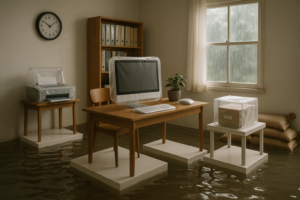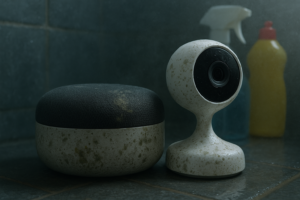It’s no secret that our climate has been changing. Whether we’re sweating through late spring heatwaves or watching rainfall pound our backyards in what feels like record-setting downpours, weather patterns are shifting. And as homeowners, we’re feeling those effects in more ways than just adjusting the thermostat or cleaning out gutters more often. One silent but serious consequence of climate change is the increased growth and spread of mold in our homes.
Mold has always been a challenge for property owners, especially in humid environments. But the game is changing. Rising temperatures, lingering humidity, and stronger storms are setting the stage for mold to thrive like never before. The bad news? Mold doesn’t just look bad or smell weird. It can cause structural damage and even take a toll on your health. The good news? Knowing what to expect and how to react can make a big difference.
How Climate Impacts Mold Growth in Homes
Climate impact on mold might seem like a stretch at first glance, but when you break it down, the science checks out. Mold loves moisture. It grows well when the air is humid and the surfaces are damp. Add warmth to the mix and you’ve got the perfect breeding ground.
With higher average temperatures, especially in the late spring and summer, more homes are seeing extended periods of warm, moist air. And humidity isn’t just about those sticky 90-degree days. When heavy rainstorms happen more often, or when a home’s interior isn’t properly ventilated, the air inside can stay damp longer. That opens the door to mold colonizing everything from drywall to carpets to insulation inside the walls.
Strong storms that flood basements, damage roofs, or cause plumbing to fail are becoming more common. Every time water gets into a space and isn’t cleaned and dried properly, mold has a head start. And since climate patterns don’t appear to be settling down any time soon, we have to start thinking about long-term homeowner mold prevention strategies.
Increased Humidity and Warmer Temperatures Indoors
The air inside your home isn’t sealed off from what’s going on outside. Try as we might, insulation and HVAC systems aren’t foolproof. When summers are longer and humidity levels spike, your indoor air can become noticeably more sticky. And that’s where mold finds opportunity.
Bathrooms, kitchens, basements, and attics already struggle with airflow. Combine that with outside humidity filtering in and you’re looking at prime real estate for mold spores. Areas around windows, under sinks, behind wallpaper, and in crawlspaces are hidden targets. Even newly constructed homes aren’t immune. In fact, tighter construction methods designed to boost energy efficiency can sometimes trap air and moisture inside, allowing mold problems to flourish unnoticed.
Storm Damage and the Rise of Water Intrusion
Let’s talk about water intrusion, one of mold’s favorite invitations into your home. With intense storms increasing across much of the country, the odds of experiencing roof damage, pipe bursts, or overflow from gutters are going up too. Each of these problems can introduce a surprising amount of moisture into spaces behind walls, beneath flooring, or within the ceiling—places where water isn’t supposed to linger.
When this water sits for even a short time, mold starts growing. The trouble is that these leaks or soaked spots often go undetected for days or weeks unless you’re specifically looking for them. That slight musty smell you notice coming from the closet could be telling you a much bigger story about what’s happening behind the drywall. And if you live in hurricane-prone regions, temporary tarp jobs and delayed roof repairs due to widespread post-storm damage can unintentionally help mold spread even before insurance claims are settled or repairs begin.
Why Mold is More Than Just a Nuisance
Too often, homeowners wait to take action on mold until they can see it, smell it, or feel its effects on their breathing. But mold doesn’t pop out of nowhere one morning like weeds in an untended garden. It builds over time and often does most of the damage hidden from view.
It’s not just walls and ceilings that suffer. Mold eats away at building materials including wood, drywall, and insulation. Over time, this compromises the integrity of those surfaces, especially if they become soggy. That can lead to warped flooring, discolored walls, or serious damage that requires full replacements. On top of that, mold spores can trigger allergy-like symptoms including sneezing, congestion, and itchy eyes. In more extreme cases, they can aggravate asthma or contribute to respiratory difficulties, especially for kids and seniors.
So, if you’re dealing with more moisture in your home because of changing weather, ignoring mold can be a costly mistake both structurally and in terms of your health.
How Homeowners Can Respond to Climate Driven Mold Risk
Now for the pressing question: how can you fight mold if it keeps getting easier for it to grow? The trick lies in thinking long term. Homeowners dealing with hot, wet summers and increasing rainfall need proactive solutions, not shortcuts.
Start by checking areas of your home where moisture gathers. Bathrooms and kitchens should always have working ventilation. Make sure exhaust fans aren’t just decorative noise makers but are actually venting outside. Dehumidifiers are also a smart investment, especially if you notice condensation on windows or musty smells in basements or attics. Even using them during particular months can make a huge difference.
It also helps to walk your property after heavy storms. Check gutters to make sure water is draining away from the foundation. Look for puddles near the siding and grassy areas around the base of your home. If water pooling is common during rain events, it might be worth regrading parts of your yard or installing a French drain system to move water out faster. The longer water sits there, the higher the odds that some of it finds its way inside.
Recognizing Hidden Mold Before it Spreads
Most homeowners picture fuzzy black spots on ceilings or floors when they think of mold. That’s definitely one sign. But some of the most persistent mold problems go unnoticed for too long simply because they’re hidden. Odor is usually the first indicator. That dusty, stale smell in a hallway closet or laundry room could be more than you think.
Pay attention to warping in floors or doors that suddenly get stuck or won’t close all the way. Mold can cause wood to swell or become misshapen. Water stains or bubbling paint and wallpaper are other subtle signs. If something seems odd and you can’t explain why a particular room always feels damp or musty, it might be time for a professional inspection. Sometimes mold hides behind walls for months before it finds a way out.
When to Call in the Pros
No one wants to bring in a mold remediation company if they don’t have to. These jobs can be complex, depending on the amount and location of the growth. But the reality is, leaving mold untreated only makes the problem worse. Especially if you’re seeing mold return over and over in the same area, or if you’ve had storm damage in the past that wasn’t fully dried or repaired quickly.
Professional teams like ours use moisture meters, infrared cameras, and air tests to locate mold you can’t see and then safely remove it. Trying to bleach or cut out a moldy section of drywall by yourself can sometimes trigger more spore release into the air, spreading the issue to other parts of the home. So, while it’s logical to try and contain the cost with a bit of DIY, know when the situation is bigger than a sponge and a spray bottle can handle.
Building Mold Resilience into Your Home Strategy
Homeowner mold prevention starts with understanding that this isn’t just an old house problem, a basement problem, or a neglect issue. It’s about knowing that climate impact reaches right inside your walls and attic, and deciding to stay a step ahead. Every next summer could be hotter. Every storm could be heavier.
Creating better moisture control inside your home is something you can plan for. Upgrading insulation, increasing ventilation, sealing small roof leaks quickly, and maintaining windows and doors all contribute. If your home is located in an area increasingly affected by climate change, building a long-term strategy that includes mold inspection, professional help after storms, and better standing water management will keep the problem small rather than allowing it to spiral.
We’re all adjusting to the new weather story. Homes that adapt to change early on are going to fare better than those that wait until the signs are visible. Don’t wait for your nose to tell you there’s mold. By that point, the structure of your home might already be paying the price.







